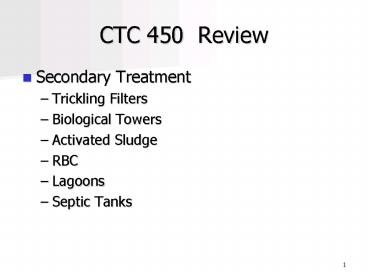CTC 450 Review PowerPoint PPT Presentation
1 / 31
Title: CTC 450 Review
1
CTC 450 Review
- Secondary Treatment
- Trickling Filters
- Biological Towers
- Activated Sludge
- RBC
- Lagoons
- Septic Tanks
2
Objectives
- Understand basic processes of sludge treatment
3
Sludge Characteristics
- 5,000 gal of sludge per 1 million gallons treated
- 4-5 solids
- (activated sludge 0.5 to 1.5)
- Must be stabilized, dewatered and disposed of
- Sludge facility costs are approximately 1/3 of
total investment
4
Characteristics
- Sludge from primary settling is anaerobic,
odorous, easily thickened, and easily dewatered - Sludge from aerated systems is odor-free, but
difficult to dewater
5
Sludge Pumps
- Positive displacement pumps
- Can control pumping rate
6
Sludge Treatment
- Thicken
- Digest
- Aerobic
- Anaerobic
- Dewater
- Dispose
7
1. Thicken
- Gravity Settling
- Dissolved air flotation
- Gravity Belt
- Centrifuge
8
Gravity Thickening
- Circular settling tanks
- Overflow returned to head of plant
- Sludge removed from the bottom
- Normal unit load 6-12 of solids per ft2 per day
- Treated wastewater (ferric chloride) is sometimes
added to - Reduce Odor
- Wash out fine SS
- Typically 80-95 of solids are captured
9
Gravity Thickening www.mvsd.org/ flow/Thick.htm
The Sludge Thickener is another settling tank
which further separates solids from the liquid.
The sludge from the bottom of the thickener is
sent to the Primary Digester. The overflow of
water from the thickener is sent back to the
Clarifiers.
10
Gravity Thickening
- Doesnt work well for activated sludge
- Better processes for activated sludge
- Dissolved air flotation
- Gravity belt
- Centrifuge
11
Dissolved Air Flotation
- Outflow 4 solids
- 85 solids recovery rate
- Polymers/flocculants may be added
- Practical loading rates
- 2 to 4 of solids per square ft per hr
12
Dissolved Air Flotationhttp//www.biomassimpianti
.it/images/impianti-dis/daf-proc.gif
13
Gravity Belt Thickeners
- Polymers added
- Sludge sprayed onto permeable belt
- Dewatered sludge falls into a hopper
- High pressure water used to clean belt
- Speed of belt can be controlled
- 90-98 solids capture rate
- Practical loading rates
- 100 to 250 gpm per meter of belt width
14
Gravity Belt Thickener www.ci.helena.mt.us
15
Centrifuge
- 400-600 gpm
- Thickened sludge of 4-8
16
Centrifuge Thickening www.sgconsulting.co.za/.
../Decanters.htm
Mode of operation The essential part of the
decanter is the rotating part which consists of a
cylindrical/conical bowl with a conveyor scroll
inside which rotates at a differential speed. The
rotating part is driven by electric motors via
belt transmission. Feed enters the bowl through a
central feed pipe. Through ports in the scroll
body, feed passes into the bowl where separation
by centrifugal force takes place. In a decanter,
the product is separated into a liquid phase and
a solids phase. The discharge of the separated
liquid can be under pressure or by gravity. The
separated solids are conveyed by the scroll to
the conical end of the bowl and are discharged.
Decanters can also be configured for gas tight
operation as may be required for toxic or
explosive materials.
17
2. Sludge Digestion
- Convert sludge so that it can be rapidly
dewatered - Anaerobic Digestors
- Single Stage
- Two-Stage
- Aerobic Digestors
18
Aerobic
- Developed specifically for activated sludge
processes w/o primary clarifiers - Aerated via diffused or mechanical aerators
19
Anaerobic
- Single stage
- Fixed cover
- Floating cover
- Two-stage
- Biological Stabilization
- Gravity Thickening
20
3. Dewatering
- Pressure filtration various types
- Centrifuge
- Drying beds
- Composting
21
Pressure Filtration
- Belt Filter Press
- More popular
- Available in small sizes
- Belts which pass over a series of rollers
- Plate-and-Frame Press
- Used for chemical sludges
- Produces very compact and dry cake
- Screw Press
- Auger screw within a metal screen
22
Belt Filter Press
http//www.cityofweirton.com/wsb/bltpress.jpg
23
BiosolidsTo Landfill
- http//www.cityofweirton.com/wsb/sludge.jpg
24
Plate and Frame Press www.asmfab.com
25
Filter Press http//www.metlabsolutions.com/Shrive
r20Press20-20side.JPG
26
http//www.fsid.cvut.cz/cz/u218/peoples/hoffman/PR
EDMETY/COVP/COV/Foto-COV/Resize20of20Snekovy20l
isdetail20vyztuzeni20sita.jpg
27
Aerated Static Pile Composting - sludge cake from
the belt filter presses is transferred by
conveyors, blended with a bulking agent (wood
chips or wood ash) to reduce its moisture
content increase porosity and facilitate
materials handling and is then placed in one of
12 concrete bins. Each bin is loaded to form a
pile which is aerated by blowers and perforated
piping to enhance aerobic decomposition and
stabilization of the sludge.
http//www.mwpca.org/billerica.htm
Curing and Storage Area - after the
sludge/bulking agent mixture is allowed to
actively compost for 14 to 21 days, the material
is subsequently stockpiled in the storage areas
adjacent to the Composting Building, where it is
allowed to cure for an additional time before it
is transported offsite for final disposal. The
end product may be marketed for beneficial use
such as landscaping or conditioning poor quality
soils.
28
Sludge Odor Control
- Odors (hydrogen sulfide, organic compounds)
- Adsorption (activated carbon)
- Biological system (wood chips or soil)
- Wet scrubbers
29
4. Sludge disposal
- Agricultural land application
- Landfill
- Incineration
30
Incinerator-Fluidized Bed
31
Regulatory Requirements
- 40 CFR Part 503 (1993-CWA)
- Encourages recycling via land application versus
disposal in a landfill or incineration - Survivability of pathogens is a concern
- Class B (not considered pathogen-free)
- Class A (pathogens below detectable limits)

